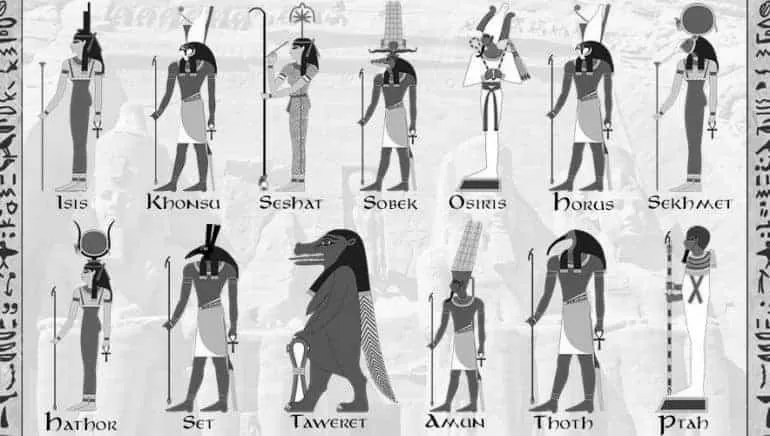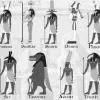Set was an all-encompassing Egyptian deity associated with many attributes. He was the god of order and justice and was related to mysterious phenomena like eclipses, thunders, and storms. His battle with the other god, Horus, was often thought to represent the struggle for Egypt’s unity.
Ma’at was a god of order and justice.
The Egyptian conception of the universe was centered on Ma’at, which encompasses several concepts in modern English: truth, order, and justice. Ma’at personified the fixed order of the universe, which existed since the beginning of the world and was essential to its cohesion. Ancient Egyptians devoted significant portions of their religious life to pursuing justice and order.
Ma’at was usually depicted as a winged woman with an ostrich feather on her head. This feather held symbolic value, as it was used in the afterlife ‘Weighing of the Heart ceremony. The Egyptians believed that the heart was to be weighed against the feather in the scale of justice, which would release a part of a person’s life force to the god Akh.
The Egyptians also worshipped Ammit, who was the deity of divine retribution. According to legend, Ammit feasted on unworthy hearts, and those who succeeded in their quest would join the celestial gods in the Afterlife. According to ancient texts, the god was depicted as half-lion, half-hippopotamus, and half-crocodile. The British Museum has a beautifully preserved papyrus that describes Ammit standing beside the scales of Ma’at. Ancient Egyptians revered Ammit, and she was an important reminder of the principles of Ma’at.
Hathor was a patron of women.
Hathor is an Egyptian deity who often depicted a cow. Her primary symbol was a headdress made of two horns with a sun disc and uraeus between them. This headdress also appeared on the head of the goddess Isis. Hathor has sometimes represented as a cow with a child suckling from her udders.
Hathor was worshiped in the early Ptolemaic Period and became associated with the Pleiades. She was also associated with pleasure and art and patronized women. Her priestesses were often joyful and were known for sharing the satisfaction of the flesh with worshippers.
Hathor’s role in Egyptian history was complex. Her worship spanned the entire nation and extended far beyond religion. Her worship was a way to unite all people and bring about social change. Her role as a patron of women was crucial for Egyptian society.
Thoth was a god of magic.
In ancient Egypt, Thoth was the god of the moon, sacred texts, mathematics, science, and magic. He was also associated with divinity and divine order. He was represented as an ibis bird or a baboon. He helped deities, provided guidance, and regulated everyday complaints.
He served the Pharaoh as his spiritual adviser and guide. He provided the Pharaoh with powerful magic to protect him from the “blow of events” – chaotic forces threatening light’s survival. This protection lasted day and night. During the daytime, the Pharaoh navigated the Nile, which is home to the underworld.
Egyptian deities were often symbolic representations of natural processes such as regeneration and death. The night and underworld were also meaningful metaphors for pre-creation and destruction. These concepts, along with the Ogdoad of chaos-gods, were worshipped at Hermopolis. The feminine, on the other hand, kept the sacred hidden.
Anubis was a protector of graves.
The Ancient Egyptians were concerned about the safety of burial sites and worshiped Anubis as a grave guardian. His primary roles were to protect the deceased, embalm the body, and guide the soul to the Afterlife. The god was also revered as the creator of mummification and embalming; in a famous story, Set gifted the god Anubis with parts of the dead and organs of the deceased, which he would later use to make himself a protector of the grave.
The image of Anubis is frequently found on the walls of royal tombs in Egypt. Before the First Dynasty, the Egyptians had already begun to develop a cult around Anubis. Invoking the god on the walls of tombs was thought to help protect the tomb from wild dogs, which would sometimes dig up corpses. The Egyptians feared these wild canines and thought a powerful canine god was the best protection against them.
Amun-Ra was a combination of two Egyptian gods.
The combination of the two Egyptian gods, Amun and Ra, was known as Amun-Ra, the creator of the universe. This god was also associated with fertility. The god was often depicted as a bearded man with a double plume and a ram, symbolizing fertility. Amun was part of the Ogdoad, a group of gods that represented the primordial elements of creation.
Amun was the son of Osiris and a great-grandson of Horus. He was the god of the sky and the divine protector of kings. His temple still exists in the ancient city of Edfu. In his mythology, he was killed by his evil brother Set and brought back to life by his sister Isis. In Afterlife, he is the primary judge in the hall of truth, weighing souls against a white feather.
The Egyptians worshiped Amun and Ra until almost the time of Christ. Amun-Ra had many faces, but they are most often depicted as a bearded man with a scepter and ankh. Usually, he is seated on a throne. In some cases, he is accompanied by a serpent.
Horus was a symbol of sacrifice.
The ancient Egyptians regarded Horus as a king and a symbol of sacrifice. According to the myth, he was born as the son of Seth and Isis and protected by her. He grew up to claim the throne in Egypt. Today, Horus is associated with the title of king and the personification of divine power. Ancient Egyptian kings believed they were descended from Horus.
The Eye of Horus was a sacred object. The left eye symbolizes the moon, while the right represents the sun. Horus lost his left eye during a battle with Khunsu, the god of youth. The left eye covered the “sky” part of his name, which is why the Eye of Horus symbolized sacrifice in Egypt.
Ancient Egyptians believed that the Pharaoh represented Horus, the personification of the heavenly forces. His divine blood made him fit to rule the nation. Thus, the Pharaoh was often called the “Living Horus.” The Pharaoh’s soul was passed on to the next Pharaoh, and the Eye of Horus was usually found on royal vestments and courts.
Atum was a frog or a frog-headed man.
The Egyptians viewed frogs as potent symbols. The ancient Egyptians placed the sign of a frog next to the name of a deceased person. They also associated the frog with the well-wishing term “live again.” This association with the frog helped them understand its role in resurrection and rebirth. In the winter, frogs hibernate in river banks and pools. This allows them to survive without food. However, the frogs appear dead in the winter until they jump out of the slime.
In the Egyptian pantheon, Atum was the sun god Re. In the Egyptian pantheon, humans and divine beings coexist. The Eye of Re, also known as wedjat, was the source of human life. However, the eye of Re became detached from its creator. In response, Shu and Tefnut attempted to retrieve it. However, the look of Re resisted them and shed tears.
Anubis was a cupid-like form of Horus.
In Egyptian mythology, the jackal god Anubis was the son of Osiris and Nephthys. He was later associated with the Greek god Hermes. He was also worshipped in Rome during the 2nd century BC. His name is also found in hermetical and alchemical texts.
While Anubis had many roles, his core attributes were related to death. The god was regarded as the guardian of the grave, and he was associated with embalming rites. He was also associated with the jackal’s head. His head color was associated with his role as a god of the dead. One example is the statue of Anubis at the Temple of Rameses II in Abydos.
Anubis played a similar role in the Afterlife. The god would weigh the dead against a feather of truth, and if their heart weighed more than the feather, Anubis would destroy them. They would be allowed into the Afterlife if their hearts were the same.







